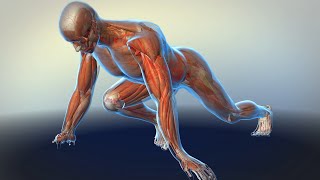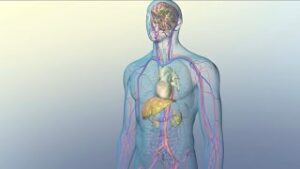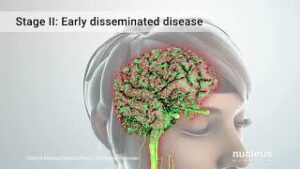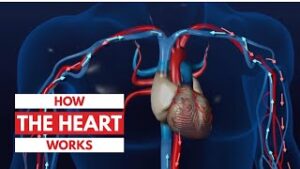![]()
MEDICAL ANIMATION TRANSCRIPT: Skeletal muscles are voluntary, controlled consciously by the nervous system, and are made up of fascicles, which are bundles of muscle fibers surrounded by connective tissue, blood vessels, and nerves. Motor nerve axons supply one or more skeletal muscle fibers, constituting a motor unit. Inside a muscle fiber, thread-like structures called myofibrils are organized into contractile units, or sarcomeres, reflecting the striations characteristic of skeletal muscle. Each sarcomere is made up of thick and thin myofilaments, strands of proteins called myosin and actin. Myosin forms thick filaments. Actin forms thin filaments. The protruding heads of myosin filaments form cross bridges that bind to actin filaments and ATP, an energy transport molecule. Thin filaments contain a sequence of actin molecules with myosin-binding sites. At rest, actin molecules bind tropomyosin and troponin, two contractile proteins that inhibit contraction. Skeletal muscle contraction begins at the muscle fibers’ plasma membrane, or sarcolemma, with invaginations called transverse or T-tubules that surround each myofibril, and open to the extracellular space. T-tubules connect to a membranous network called the sarcoplasmic reticulum that store calcium and transfer ions via voltage-gated channels into the myofibril sarcoplasm to regulate muscle contraction. In the first step of muscle contraction, called excitation, a motor nerve fires an impulse, or action potential, across the neuromuscular junction, depolarizing the sarcolemma, and generating an action potential that spreads through the sarcolemma into the T-tubules, and excites the muscle fiber. The second step is coupling, wherein the action potential depolarizes the T-tubules. Channels in the sarcoplasmic reticulum release calcium into the sarcoplasm. Along the myofilaments, troponin binds calcium and separates from tropomyosin. In the third step, called contraction, tropomyosin shifts away from actin to expose the myosin-binding sites, enabling myosin to bind to actin, resulting in the activation of ATP and the cross bridges. Released energy causes the myosin heads to rotate and pull the thin filaments inward, sliding past the thick filaments and shortening the sarcomere. The fourth step of muscle contraction is relaxation, in which calcium ions return to the sarcoplasmic reticulum and break the myosin-actin bonds. The cross bridges disengage, and the sarcomere lengthens, resulting in relaxation of the muscle and the end of the contraction. ♪ [music] ♪
#MuscleContraction #muscles #physiology
ANM11013




